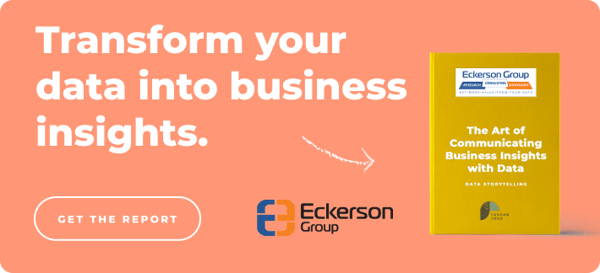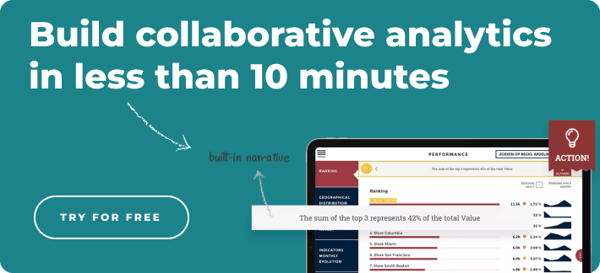Collaborative analytics fits into a broader trend in analytics to approach business intelligence from a community-driven perspective. By combining business intelligence software with collaboration tools, a broad spectrum of people within an organization (and beyond) can participate in data analytics.
A collaborative analytics approach emphasizes problem-solving since the most valuable insights aren't generated in a vacuum. Data analysts cannot function effectively without input from people who have a thorough understanding of the industry, speak to customers, work on product development, manage production, etc.
.png?width=600&name=Blog%20Graphics%20(18).png)
Why companies should implement collaborative analytics
With the changing business landscape data and analytics runs through the decision-making process across multiple departments. It is no longer relegated to finance and sales numbers. The marketing team needs to know the number of visits and rate of purchase, the product team has to understand bounce rates, the HR team wants to monitor employee productivity, and the customer success team tracks the frequency and severity of customer issues that arise. No team can function independently of the other departments with analytics being a common thread. Analytics is the driving force that provides actionable insights leading to more informed business decisions. So it seems fit that all departments should collaborate on the analytics so they can understand the bigger picture and the priorities of each department.
Apart from overall organizational alignment, collaborative analytics also come with the following benefits.
Data exploration for non-technical users
Unless someone points them out to the larger team, data sources and datasets can easily remain undiscovered. By involving a variety of people in the data analytics process, an organization can identify and share all its valuable data and make full use of it. This is why at Toucan we make the discovery process easy with 0-code data exploration and modification.
There is an abundance of data available to companies. But 73% of it goes unused for analytics. A collaborative team can make better use of data when all relevant data is brought to bear on a given question. Data teams are able to endorse accurate and relevant data, and business users know how to interpret it.
Build for the end user
Data teams limit domain experts to static dashboards, wasting much of their expertise. Due to their on-the-ground knowledge of the situation, these domain experts can ask more meaningful follow-up questions. This is why there is an immediate need to democratize data and put it in the hands of decision-makers in every department. This was the main reason why at Toucan we created a guided analytics platform with context at every turn. Business users irrespective of technical level should have access to data and analytics. This is the only way to effectively grow your organization. Collaboration analytics maximizes the investment that organizations are already making in this knowledge.
Actionable insights everyone can understand
Data teams specialize in data sourcing, processing, modeling, and analytics. The majority of their time is spent working on the production line, not talking to customers or working with the product. As a result, they are proficient at identifying trends and issues, but they are not always able to figure out why those trends and issues occur. Their analysis is guesswork. This is why it is important for them to get input from people who have domain expertise and can see and hear things that aren't reflected in the statistics.
This input can save a company from making costly errors due to incorrect insights leading to ill-informed decisions. For instance, an analyst may discover that sales have suffered in one region while they continue to thrive in other regions. Without the territory manager's input, we will never know what the real cause is. The company could waste millions of dollars rectifying a “problem” that doesn’t exist — only to discover that the drop was due to a completely different problem that requires another outlay of cash in order to solve the issue.
Faster decision making
The faster you can collaborate and bring all knowledge and perspectives together, the faster your speed to insight. Actionable insights are the biggest bottleneck to effective decision-making. Business decisions get actively delayed because analytics are locked in ivory towers with limited access leading to active loss of revenue. Yes, a certain level of collaboration can happen without the appropriate tools and processes. In many cases, the companies that "win" are those that are able to move quickly - before their competitors. And in cases where insights are necessary to solve problems, speed can mean significant cost savings.
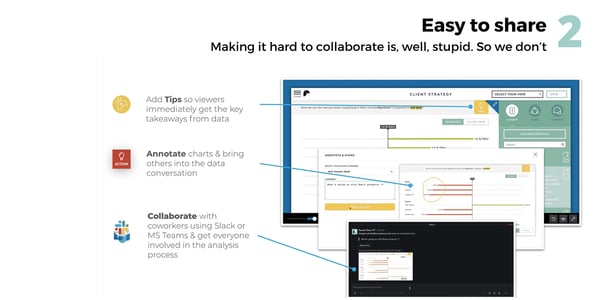
Roadblocks to collaborative analytics
The reality is that roadblocks prevent most organizations from fully embracing collaboration. Companies can remove these roadblocks by addressing what's holding them back. There are the major cultures
No collaboration in BI tools
The majority of legacy tools have bolted-on analytics collaboration functionality, but they weren't designed with collaboration in mind from the start. As a consequence, business users are unable to get as involved as they would like (and should be) due to clunky or complicated user experiences. You need a tool that has a user interface that is easy to use, so that not just those with technical knowledge can explore data.
Limited access to business users
Business users cannot ask unique questions, or explore reports with set parameters even when collaboration tools are used as foundational features. It is only the technical members of the data team who are able to collaborate effectively. Data modeling and querying are not available to business users beyond a limited, pre-designed sandbox.
Subpar collaboration in data warehouses
Collaborative analytics requires the right infrastructure with the right capabilities. Most traditional data warehouses were not built to traverse and display large data sets in an easy-to-understand manner. Using modern cloud data warehouses like Snowflake and Google BigQuery, it is possible to store extensive amounts of data, scale to meet the analytical demands of entire companies, and centralize company data for holistic analysis. Any company considering a collaborative and community-driven approach to analytics must meet these requirements.
Lack of governance in BI tools
The current approach used by most companies right now is to lock the data in an ivory tower and let only data analysts or architects access it. This prevents the democratization of data. Data governance must be modernized to facilitate data access, exploration, and analysis without compromising security. In order for your analytics and BI solution to be truly community-driven, you must ensure that data is accessible and approachable for everyone while maintaining strict compliance and security standards.
What to look for in collaborative analytics & BI software
Because many collaborative analytics tools are limited in their collaborative functionality, you’ll want to do your research before committing to one. Here’s what to look for in collaborative BI software to ensure you experience the benefits that a community-driven approach has to offer.
Extensive collaboration tools
Look for team workspaces that allow users to collaborate on analysis as individual teams and share data with other teams in the organization. Toucan comes with a built-in comments section where various team members can provide context and share insights. Further, there is the annotate and share feature where teams can point to specific details or highlight insights and share them via email, slack or as a PDF.
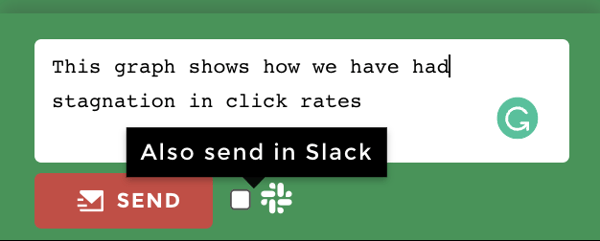
Governance
Ensure that business users won't be prevented from fully utilizing the tool due to security concerns. With robust permissions and security features, along with a balanced data governance program, people who should have access to the tool can explore it fully.
Self-service analytics
Your analytics should be built for non-technical users and designed to gain actionable insights. This is why Toucan is a 0-code solution and focuses on guided analytics. There should be context everywhere for all users to understand the analytics. On top of titles and descriptions, analytics should come with tips, alerts, glossary and HKPs to make sure that everyone can understand the analytics displayed.
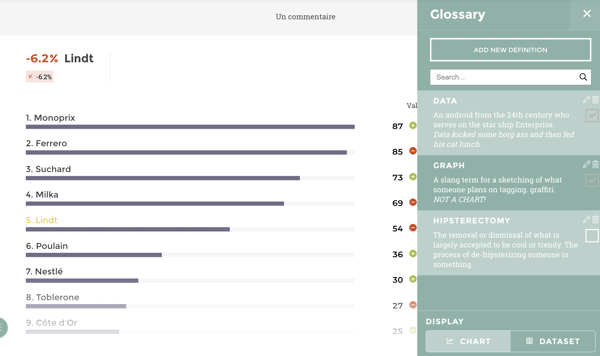
Reusable datasets and analyses
An essential part of collaboration is the ability to build on the work of others. Your collaborative analytics tool should allow you to reuse datasets and analyses that other teams have already added and created.
Collaborative analytics is the future
Due to the invaluable benefits of collaborative analytics, many organizations are in a race to become more community-driven. As the research shows, the majority of those companies that are not yet taking advantage of collaborative analytics processes are planning to implement collaborative analytics in the future. Only 11% of companies say they don’t plan to follow the collaborative path.
To start seeing the benefits that community-driven analytics offers and compete with organizations that are, you’ll need to start building your collaborative capabilities and culture now.


